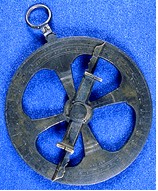
In 2013, the Champlain Park community is celebrating its natural and human history.
What’s our story?
Our natural history embraces and celebrates the diversity of trees that grace our urban neighbourhood—especially the gnarly and majestic bur oaks. Champlain Park is home to 22 giant bur oaks, estimated to be more than 160 years old, and many smaller bur oaks, too.
Since 2010, the Champlain Oaks Project has been celebrating the old oaks, and planting seedlings from this ancient genetic stock on both private and public land in our neighbourhood.
Our natural history intersects with our human history through two individuals: Captain Daniel Keyworth Cowley, for whom three streets are named, and Samuel de Champlain. The latter traveled up the Ottawa River in 1613 – 400 years ago past the shoreline that is so familiar to our own community. Champlain lost his astrolabe further upstream, near the town of Cobden, Ontario.
Our very own Captain Cowley acquired that astrolabe in 1867 when a lad of 14 found it while clearing a field and then turned it over to the steamboat captain.
This PDF describes our community’s natural and human history.
This file provides a short version of the timeline described in the history file.
Find out more about the fascinating history of The Cowley Family Saga in Canada.
PART 1: From Sherwood Forest to the NHL
PART 2: The Saga Continues
PART 3: Back to the Beginning
You may also want to read the posts in the History Category for more history.
There’s also a summary of the monument installation at the fieldhouse, which references articles that mention a bit of the history.
There isn’t much readily available information about our area of town, but Dave Allston’s http://kitchissippimuseum.blogspot.ca/ is collecting history, writing up stories, and has references to the available books about our area of Ottawa. He did write about the real estate manipulations that brought Island Park Drive through the neighbourhood, increasing the value of the land that Robert H. Cowley owned.
CLIMB ABOARD FOR A SHORT HISTORY OF THE STREETCAR
The streetcar opened up Ottawa to the west, making both the city and the suburbs more accessible. Almost overnight it turned vacant farmland into valuable real estate. (links to article in the Kitchissippi Times)
https://ottawarewind.com/2016/11/28/the-nuclear-reactor-that-was-once-at-tunneys-pasture/
Recently the National Capital Commission revealed plans to make Tunney’s Pasture the site of the new Civic Hospital campus. The current Tunney’s federal government complex is a mix of mid-century and 1970s office buildings and towers, a boring collection of grey concrete. Something that is of more excitement however, is the fact that the area was once home to a nuclear reactor.
![[Logo as used in Home Page and Elsewhere]](https://champlainpark.org/wp-content/uploads/2020/10/cropped-champlain-park-logo-emily-2020.08.06.jpg?w=104)
